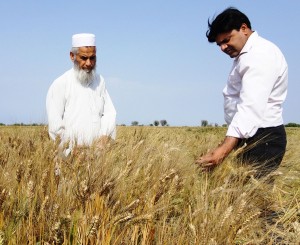
Photo: Attiq Ur Rehman/Cimmyt.
In response to rapidly-changing food preferences in Pakistan, including a latent unmet demand for pasta products, CIMMYT-Pakistan has been working to develop the country’s durum wheat market and varieties that satisfy the required grain quality attributes, in addition to high yields and disease resistance.
According a 2014 study by the Woodrow Wilson International Center for Scholars, Pakistan is urbanizing at an annual rate of 3 percent—the fastest pace in South Asia. “More Pakistanis are living in cities than ever before,” said Krishna Dev Joshi, CIMMYT wheat improvement specialist. “As a result, demand for durum wheat products like macaroni or spaghetti is rising. But farmers are not growing durum wheat because there is no a clear price advantage or assured markets. At the same time, private investors will not develop new milling facilities or markets without guarantees of durum wheat grain supplies from farmers.”
To help break the impasse, CIMMYT has been testing and evaluating 925 durum wheat lines in Pakistan since 2011, and identified 40 durum wheat lines as having appropriate combinations of high yield, protein, yellowness and sedimentation. The yield stability of lines across locations and years indicates that durum wheat could be grown in environments similar to those of the trial sites, increasing the chances for uptake of this new crop. “One challenge, though,” said Joshi, “is that durum yields were only slightly higher than those of bread wheat, posing a challenge for the uptake by farmers of durum wheat.”
Activating Durum Markets from the Ground Up
The Center also led a 2014 durum value chain study involving 85 respondents including farmers, millers, the processing industry, restaurants, seed companies, grain dealers and consumers across five locations. They were queried regarding their awareness of durum wheat, as well its production, usage and future prospects in Pakistan. “A complete lack of durum milling technology is the main obstacle to commercializing this crop,” Joshi said.
Value chain actors themselves were only marginally aware of durum wheat and associated technologies. However, 60% of millers stated they would be willing to invest in durum wheat if it became an openly-traded commodity, policies fostered market price premiums, durum milling machinery could be acquired at subsidized rates and local and foreign manufacturers were linked.
For durum wheat production to take hold in Pakistan, milling technology would have to be adapted or farmers would have to find a niche in the international market. Government support is necessary in either case.
Despite these challenges, the durum wheat market is slowly being developed. The first national durum wheat workshop in Pakistan last September brought together farmers, millers, processing industries, dealers, seed companies, extension professionals, researchers and policy makers to share knowledge, experiences and ideas for a durum wheat value chain. The 10 best durum wheat lines are being evaluated in wheat trials across 9 locations right now.
CIMMYT representatives including Joshi will take part during 31 May-2 June in the international conference “From Seed to Pasta and Beyond: a Sustainable Durum Wheat Chain for Food Security and Healthy Lives,” with experts from around the world.
 Nutrition, health and food security
Nutrition, health and food security 
